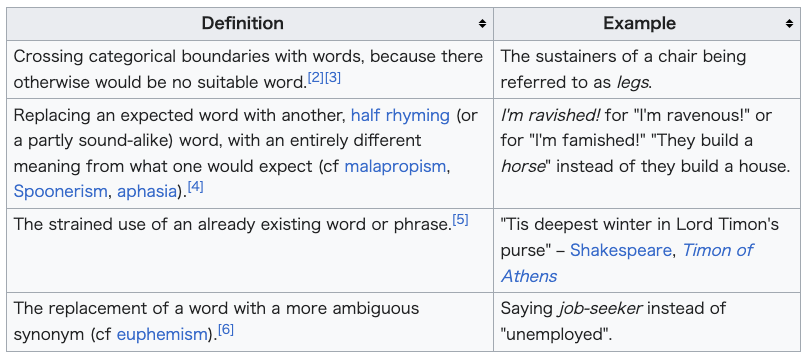Catachresis
(from Greek κατάχρησις, "abuse"), originally meaning a semantic misuse
or error—e.g., using "militate" for "mitigate", "chronic" for "severe",
"travesty" for "tragedy", "anachronism" for "anomaly", "alibi" for
"excuse", etc.—is also the name given to many different types of
figures of speech in which a word or phrase is being applied in a way
that significantly departs from conventional (or traditional) usage.[1]
|
カ
タクレシス(ギリシャ語のκατάχρησις、「乱用」に由来する)は、本来は意味上の誤用や誤りを意味するが、ある単語や語句が従来の用法から大きく
逸脱した形で適用される、さまざまなタイプの言葉の綾につけられた名称でもある;例えば、「militate 」を 「mitigate
」に、「chronic 」を 「severe 」に、「travesty 」を
「tragedy 」に、「anachronism 」を 「anomaly 」に、「alibi 」を 「excuse 」に、といった具合である。
|
 |
様々な定義
カタクレシスには様々な定義がある。
|
【定義】
Crossing categorical boundaries with words, because there otherwise would be no suitable word.[2][3]
言葉でカテゴリー境界を越える, そうでなければ適切な言葉がないからだ。
|
【実例】
The sustainers of a chair being referred to as legs.
椅子の支柱は脚と呼ばれる。
|
Replacing
an expected word with another, half rhyming (or a partly sound-alike)
word, with an entirely different meaning from what one would expect (cf
malapropism, Spoonerism, aphasia).[4]
予想される単語を、予想される意味とは全く異なる意味を持つ、半韻を踏んだ(または部分的に音に似た)別の単語に置き換える(malapropism, Spoonerism, aphasiaを参照)[4]。
|
I'm ravished! for "I'm ravenous!" or for "I'm famished!" "They build a horse" instead of they build a house.
I'm ravished!(私は狂喜した)を 」I'm ravenous!(私は強欲だ)、または I'm famished!"(私は腹ペコだ)と言う。「They build a horse=家を建てる」の代わりに「they build a house=馬を建てる」。
|
The strained use of an already existing word or phrase.[5]
すでに存在する単語やフレーズを無理に使うこと[5]。
|
"Tis deepest winter in Lord Timon's purse" – Shakespeare, Timon of Athens
「ティモン卿の財布は最も深い冬である」-シェイクスピア『アテネのティモン』
|
The replacement of a word with a more ambiguous synonym (cf euphemism).[6]
ある単語を、より曖昧な同義語で置き換えること(婉曲表現)[6]。
|
Saying job-seeker instead of "unemployed".
「失業者」ではなく「求職者」と言う
|
Examples
Dead people in a graveyard being referred to as inhabitants is an example of catachresis.[7]
Example from Alexander Pope's Peri Bathous, Or the Art of Sinking in Poetry:
Masters of this [catachresis] will say,
Mow the beard,
Shave the grass,
Pin the plank,
Nail my sleeve.[8]
|
例
墓地の死者が住民と呼ばれるのは、カタクレシスの一例である[7]。
アレクサンダー・ポープの『Peri Bathous, Or the Art of Sinking in Poetry』からの例:
この[カタクレシス]の達人は言うだろう、
ひげを刈れ、
草を刈れ、
板をとめよ、
袖に釘を打つ。
|
Use in literature
Catachresis is often used to convey extreme emotion or alienation. It
is prominent in baroque literature and, more recently, in dadaist and
surrealist literature.[citation needed]
|
文学での使用
カタクレシスは極端な感情や疎外感を伝えるためによく使われる。バロック文学や、最近ではダダイズムやシュルレアリスム文学で顕著である[要出典]。
|
Use in philosophy and criticism
In Jacques Derrida's ideas of
deconstruction, catachresis refers to the original incompleteness that
is a part of all systems of meaning. He proposes that metaphor and
catachresis are tropes that ground philosophical discourse.[9][citation
needed]
Postcolonial theorist Gayatri
Spivak applies this word to "master words" that claim to represent a
group, e.g., women or the proletariat, when there are no "true"
examples of "woman" or "proletarian". In a similar way, words that are
imposed upon people and are deemed improper[by whom?] thus denote a
catachresis, a word with an arbitrary[clarification needed] connection
to its meaning.[citation needed]
In Calvin Warren's Ontological Terror: Blackness, Nihilism, and
Emancipation,[10] catachresis refers to the ways Warren conceptualizes
the figure of the black body as vessel or vehicle in which fantasy can
be projected. Drawing primarily from the "Look a Negro" moment in
Frantz Fanon's Black Skin, White Masks, Chapter 5: "The Fact of
Blackness",[11] Warren works from the notion that "the black
body…provides form for a nothing that metaphysics works tirelessly to
obliterate", in which "the black body as a vase provides form for the
formlessness of nothingness. Catachresis creates a fantastic place for
representation to situate the unrepresentable (i.e., blackness as
nothingness).
In the 20th century, other philosophers embraced the view that
metaphorical "category mistakes" or "sort-crossings" such as
catachresis also have the potential of leading unsuspecting users into
considerable obfuscation of thought within the realm of epistemology.
Included among them is the Australian philosopher Colin Murray
Turbayne.[12] In his book The Myth of Metaphor, Turbayne argues that
the use of metaphor is actually essential to any language system which
claims to embody richness and depth of understanding.[13] He also
demonstrates, however, the dangers associated with literal
interpretations of several metaphorical constructs which prevail in the
modern scientific materialism of the Western world including: the
mechanistic Cartesian and Newtonian depictions of the universe as
little more than a "machine", [14] and the concepts of "substance" and
"substratum".[15][16][14] He further argues that modern man has
unknowingly fallen victim to such metaphors through the repeated
utilization of literal interpretation and has therefore needlessly
rejected alternative metaphorical formulations which may be more
beneficial in nature.[17][14]
|
哲学と批評における用法
ジャック・デリダの脱構築の思想において、カタクレシスとは、あらゆる意味体系の一部である元来の不完全性を指す。彼はメタファーとカタクレシスは哲学的言説の根拠となる用語であると提唱している[9][要出典]。
ポストコロニアル理論家のガヤトリ・スピヴァクは、「女性」や「プロレ
タリア」の「真の」例が存在しないにもかかわらず、ある集団、例えば女性やプロレタリアートを代表すると主張する「マスター・ワード」にこの言葉を適用し
ている。同様に、人々に押し付けられ、[誰によって?]不適切とみなされる言葉は、このようにカタクレシス、つまりその意味と恣意的[明確化が必要]なつ
ながりを持つ言葉を示す[要出典]。
※J. Derrida, Margins of Philosophy, trans., Alan Bass, Brighton: Harvester Press 1982, 255. 3 Ibid., 256.
カルヴィン・ウォレンの『存在論的恐怖』では Blackness, Nihilism, and
Emancipation』[10]において、カタクレシスとは、幻想が投影される器や乗り物としての黒人の身体の姿をウォーレンが概念化する方法を指
す。主に、フランツ・ファノンの『黒い肌、白い仮面』第5章「黒人の事実」に登場する「黒人を見よ」という瞬間から[11]、ウォーレンは「黒人の身体
は......形而上学が不断に消し去ろうとする無に形を提供する」という概念に基づき、「花瓶としての黒人の身体は、無という形のないものに形を提供す
る」のである。カタクレシスは、表象不可能なもの(すなわち、無としての黒)を位置づけるために、表象のための幻想的な場所を作り出す。
20世紀には、他の哲学者たちも、カタクレシスのような比喩的な「カテゴリー・ミス」や「ソート・クロス」が、認識論の領域において、無防備な使用者を思
考のかなりの難解さへと導く可能性があるという見解を受け入れた。その中にはオーストラリアの哲学者コリン・マレー・ターベインも含まれている[12]。
ターベインはその著書『The Myth of
Metaphor(比喩の神話)』の中で、比喩の使用は、豊かさと理解の深さを体現すると主張する言語システムにとって、実際には不可欠であると主張して
いる。 [13]しかし、彼はまた、西洋世界の近代科学的唯物論に蔓延しているいくつかの比喩的な構成の文字通りの解釈に伴う危険性を示している。
[15][16][14]彼はさらに、現代人は文字通りの解釈を繰り返し利用することによって、知らず知らずのうちにそのようなメタファーの犠牲になって
おり、そのため本質的にもっと有益であるかもしれない代替的なメタファーの定式化を不必要に拒絶してきたと論じている[17][14]。
|
"first
the violent and forced abusive inscription of a sign, the imposition of
a sign upon a meaning which did not yet have its own proper sign in
language. So much so that there is no substitution here, no transport
of proper signs, but rather the irruptive extension of a sign proper to
an idea, a meaning, deprived of their signifier. A ‘secondary’ original.
J. Derrida, Margins of Philosophy, trans., Alan Bass, Brighton: Harvester Press 1982, 255. 3 Ibid., 256.
|
「ま
ず、暴力的かつ強制的に記号を乱用すること、つまり、言語におけるそれ自身の適切な記号をまだ持っていない意味に記号を押しつけることである。つまり、こ
こには代用も、適切な記号の移送もなく、むしろ、シニフィエを奪われたイデア、意味に適切な記号の乱暴な拡張なのである。第二の」オリジナルである」。
J. Derrida, Margins of Philosophy, trans., Alan Bass, Brighton: Harvester Press 1982, 255. 3 Ibid., 256.
|
|
|
|
|
|
|



 ☆
☆